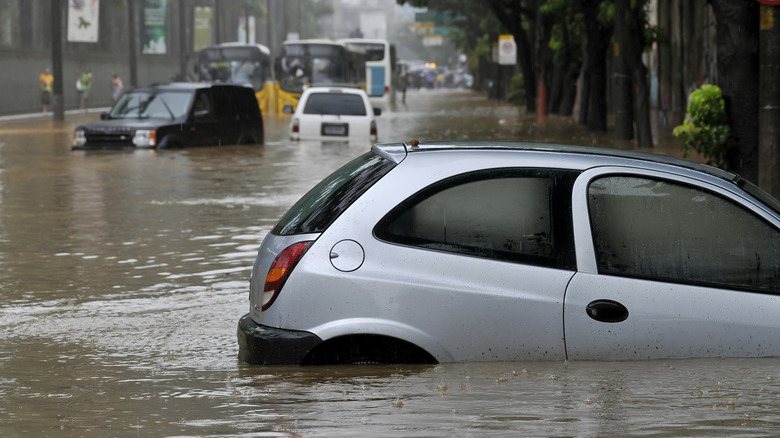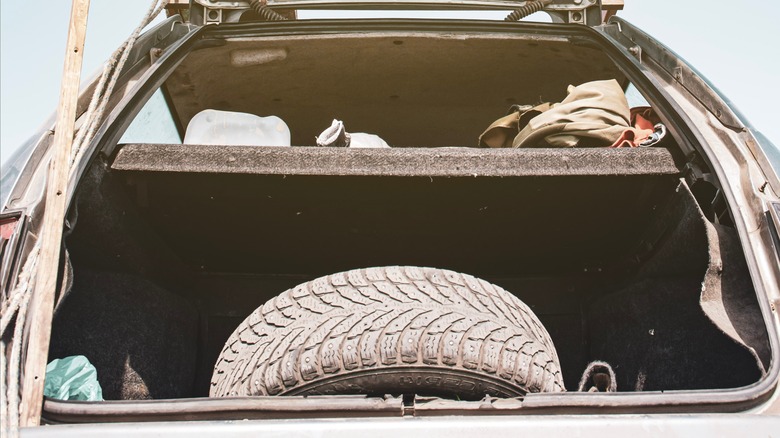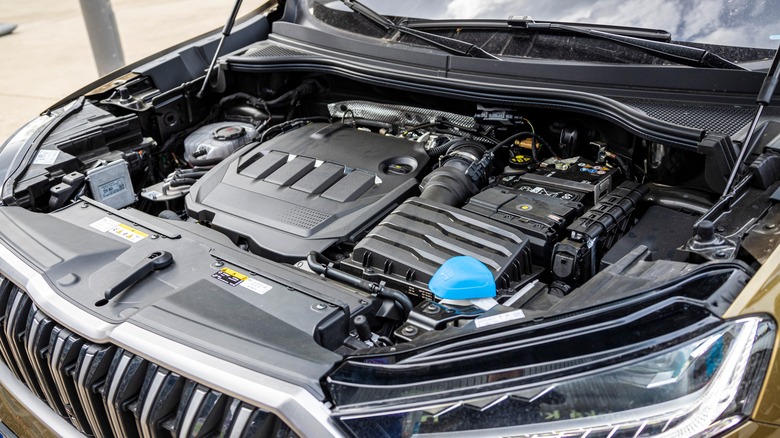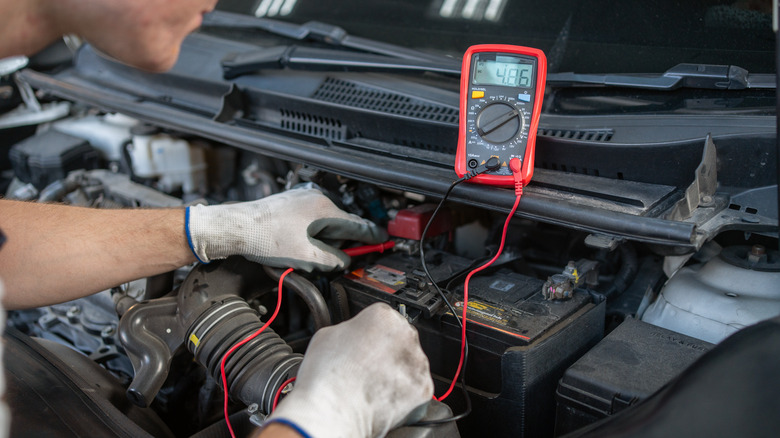5 Ways To Tell If A Car Had Flood Damage
Exploring options at a car dealership is an exciting prospect for most people. There are obviously a number of mistakes that buyers can fall victim to at dealerships (as well as problem areas when buying used cars, specifically), but most car buying experiences are filled with excitement. The idea of selecting a new ride to help amplify your personal mobility for the foreseeable future comes with plenty of hope and positivity. When considering a used model — either at a dealership lot or through a private seller — there's usually a consideration to be made about the car's age versus the mileage it's logged. But other factors also come into play.
One issue that can be a real problem for prospective buyers is water damage. If a vehicle has been through flood conditions or excessive water damage as a result of other natural disasters like a hurricane, some of its components could be affected. Water-damaged cars often feature all manner of problems from bad smells to performance issues. While a flooded vehicle is often one that's written off as a total loss, that doesn't prevent unscrupulous sellers from pawning them off on unsuspecting buyers. Here's what to look out for if you're buying a used car to avoid getting caught with a hidden flood-damaged model.
You suspect that car has had its title 'washed'
"Title washing" is one of a few car scams that can catch even the most diligent buyers. The practice involves relocating a damaged vehicle and registering it in a new state. Regulations that govern how a car can and should be registered differ from state to state. In one state, a car that's been found to have flood damage must be titled with this information prominently displayed. In other states, the same caveats aren't necessarily required. This means that a seller looking to hide previous damage could realistically accomplish that task by relocating a vehicle and then retitling it.
In many instances, damage from flooding and hurricane surges that impact cars in the southeast can be title washed if a seller brings the vehicle up north or out west. You may also encounter a seller attempting to pass on the car with only a bill of sale or with a "lost title." These can be signs someone tried to hide negative information that would fundamentally change the car's value or sale. Another common practice involve a rapid series of re-registrations in different locations. This may be done in a direct effort to obscure or scrub damaging details off the vehicle's legitimate title paperwork.
Look for debris and water lines in the spare tire compartment under the trunk
One of the most telling signs that you're dealing with a vehicle with floodwater contact is simply looking at one. After liquid has made its way into a vehicle, it can show notable water lines and debris could be lurking in a vehicle's interior even after the water has dried. A person trying to pass off a car that has flooded will likely try to clean up signs of damage. Scrubbing the surfaces of a car's interior can be enough to remove telltale markers if the water damage wasn't particularly intense. When it comes to seats and soft surfaces, a little more detail may be required, and a committed restorer might be able to hide the issue. Someone motivated enough to hide flood damage will scrub away water lines and vacuum debris that may have collected inside. But there's one spot that is often overlooked in many car cleaning operations.
Cleaning up the trunk might seem obvious, but checking where the spare tire is house is a more common oversight. Not everyone looking to pass off a water-damaged car will have the same detail=oriented approach. Checking this area is a great way to catch flood damage.
Carefully inspect the tight recesses in the engine bay
Another area that should be on your flood checklist is your car's engine bay. Under the hood are complicated mechanics, and many of them are crammed in tight together. Opening up the hood yourself, you might know what to look for, but it depends on your level of car knowledge. Because of the nature of this area of the car housing its "guts," it can be a major burden to clean up debris that is trapped here. Even the most diligent scammers can easily miss leaves, twigs, or mud that has collected inside the engine or its other compartments during flood exposure.
Generally speaking, when you pop the hood you'll often find grease and other areas that are accessible from above. But if there is mud and other grime trapped down farther into the compartment, it may be a case of flooding exposure.
You find a musty smell lingering inside the car
It's incredibly hard to get rid of the sensory after effects of standing water. Spilling a drink on your seat or getting a little rain through the window isn't really out of the ordinary. But if your seats and soft interior materials are exposed to standing water for a prolonged period of time (like in the case of these classic cars salvaged from rivers and lakes) you'll be looking at a different kind of clean up.
Major water exposure like this can warp materials or result in discoloration. But the smell is often the main issue that owners must contend with. Modern vehicles are built with precision and parts that come together in a tight package. This maximizes the utility of your vehicle for carrying people and things from place to place. But this means it could be hard to access to spaces say underneath seats or in the ceiling panels without totally gutting soft coverings. It's incredibly difficult to completely dry out a saturated seat cushion for instance. Within the vehicle it may be difficult for water to find its escape once it has worked its way into fabric. If you open the door to a car you want to buy and catch a hint of mustiness, there may be water somewhere in the vehicle that hasn't been dealt with. Flooding could be the cause.
Test electronics systems and investigate light assemblies
One more sign of a vehicle that's seen heavy water exposure involves its electronics systems. Electronic components are sensitive, to say the least. Bathing your sound system or lighting array can damage these components beyond repair. The solution may be a complete rewire, a difficult fix even for experienced automotive electricians. Other problem areas show themselves in different ways. While living in the Middle East years ago, I once unknowingly (at the time) bought a car that had been shipped over from New Orleans after Hurricane Katrina. The vehicle ran fine and there was no lingering smell or debris to be found within it. However, the vehicle frequently experienced quirky electronic failures. Sometimes the lights on the dashboard would flicker and go out, and on other occasions the entertainment system would die for a day or more at a time.
Failing electronics as a result of water exposure show themselves in all sorts of ways. Damage can be seen in the parts themselves or in the wiring that brings electricity from the power source. It could be hard to put your finger on what the problem is, but you can be sure that if you are in a vehicle with failures involving electronic components, the car may have been exposed to standing water at some point in the past.





